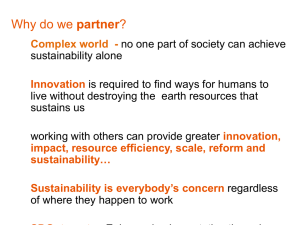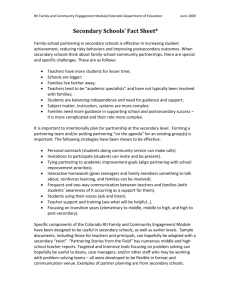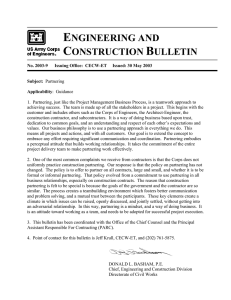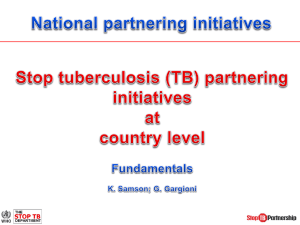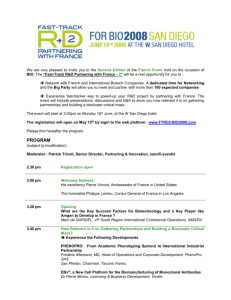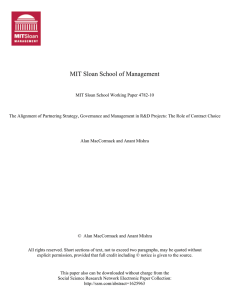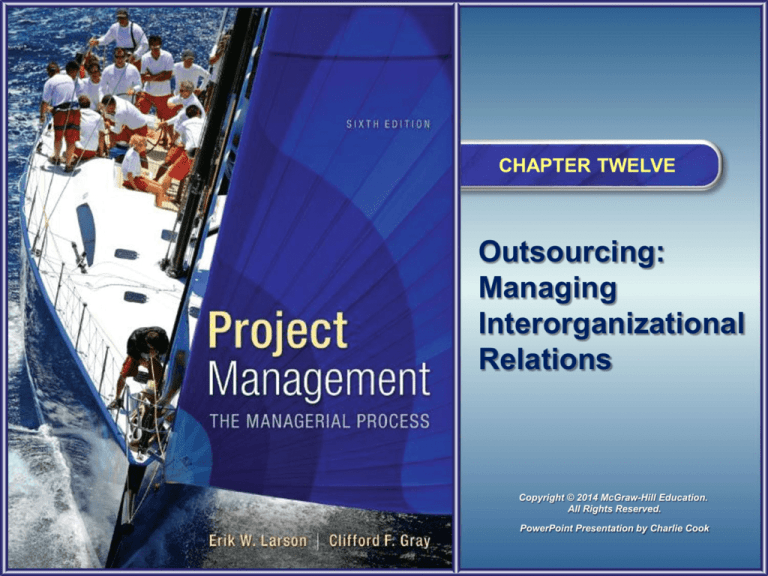
CHAPTER TWELVE
Outsourcing:
Managing
Interorganizational
Relations
Copyright © 2014 McGraw-Hill Education.
All Rights Reserved.
PowerPoint Presentation by Charlie Cook
Where We Are Now
12–2
Introduction to Project Partnering
• Partnering
– The process of transforming contractual arrangements
into a cohesive, collaborative team that deals with
issues and problems encountered to meet a
customer’s needs.
• Assumes that the traditional adversarial relationship between
the owner and contractor is ineffective and self-defeating.
• Assumes that both parties share common goals and mutually
benefit from the successful completion of projects.
– Factors favoring partnering:
• Existence of common goals
• High costs of the adversarial approach
• Shared benefits of the collaborative approach
12–3
Reclining Chair Project
FIGURE 12.1
12–4
Outsourcing Project Work
• Advantages
– Cost reduction
– Faster project
completion
• Disadvantages
– Coordination
breakdowns
– Loss of control
– High level of expertise
– Interpersonal conflict
– Flexibility
– Security issues
– Political hot potato
12–5
Best Practices in Outsourcing Project Work
• Well-defined requirements and procedures.
• Extensive training and team-building activities.
• Well-established conflict management processes
in place.
• Frequent review and status updates.
• Co-location when needed.
• Fair and incentive-laden contracts.
• Long-term outsourcing relationships.
FIGURE 12.2
12–6
Key Differences Between Partnering and Traditional
Approaches to Managing Contracted Relationships
Partnering Approach
Traditional Approach
Mutual trust forms the basis for
strong working relationships.
Shared goals and objectives
ensure common direction.
Suspicion and distrust; each party
is wary of the motives of the other.
Each party’s goals and objectives,
while similar, are geared to what is
best for them.
Independent project teams; teams
are spatially separated with
managed interactions.
Communications are structured
and guarded.
Joint project team exists with
high level of interaction.
Open communications avoid
misdirection and bolster effective
working relationships.
Long-term commitment provides
the opportunity to attain
continuous improvement.
Single project contracting is normal.
TABLE 12.1
12–7
Key Differences Between Partnering and
Traditional Approaches …(cont’d)
Partnering Approach
Traditional Approach
Objective critique is geared to
candid assessment of
performance.
Access to each other’s
organization resources is
available.
Total company involvement
requires commitment from CEO
to team members.
Integration of administrative
systems equipment takes place.
Risk is shared jointly among the
partners, encouraging innovation
and continuous improvement.
Objectivity is limited due to fear of
reprisal and lack of continuous
improvement opportunity.
Access is limited with structured
procedures and self-preservation
taking priority over total optimization.
Involvement is normally limited to
project-level personnel.
Duplication and/or translation takes
place with attendant costs and delays.
Risk is transferred to the other party.
TABLE 12.1 (cont’d)
12–8
Strategies for Communicating
with Outsourcers
STRATEGY 1: Recognize cultural differences
STRATEGY 2: Choose the right words
STRATEGY 3: Confirm your requirements
STRATEGY 4: Set deadlines
12–9
Project Partnering Charter
FIGURE 12.2
12–10
Preproject Activities—Setting the Stage
for Successful Partnering
• Selecting a Partner(s)
– Voluntary, experienced, willing,
with committed top management.
• Team Building: The Project Managers
– Build a collaborative relationship among
the project managers.
• Team Building: The Stakeholders
– Expand the partnership commitment to
include other key managers and specialists.
12–11
Project Implementation—Sustaining
Collaborative Relationships
• Establish a “we” as opposed to “us and them”
attitude toward the project.
– Co-location: employees from different organizations
work together at the same location.
• Establish mechanisms that will ensure the
relationship withstands problems and setbacks.
–
–
–
–
Problem resolution
Continuous improvement
Joint evaluation
Persistent leadership
12–12
Project Completion—Celebrating Success
• Conduct a joint review of accomplishments
and disappointments.
• Hold a celebration for all project participants.
• Recognize special contributions.
12–13
Sample Online
Partnering Survey
FIGURE 12.4
12–14
Why Project Partnering Efforts Fail
• Causes of Partnering Failures
– Senior management fails to address problems or
does not empower team members to solve problems.
– Cultural differences are not adequately dealt with
such that a common team culture develops.
– No formal evaluation process is in place to identify
problems and opportunities at the operating level or
to assess the current state of the partnering
relationship.
– A lack of incentive for continuous improvement by
contractors participating in the partnering relationship.
12–15
Advantages of Long-term Partnerships
• Reduced administrative costs
• More efficient utilization of resources
• Improved communication
• Improved innovation
• Improved performance
12–16
The Art of Negotiating
• Project management is NOT a contest.
– Everyone is on the same side—OURS.
– Everyone is bound by the success of the project.
– Everyone has to continue to work together.
• Principled Negotiations
1. Separate the people from the problem
2. Focus on interests, not positions
3. Invent options for mutual gain
4. When possible, use objective criteria
TABLE 12.2
12–17
The Art of Negotiating (cont’d)
• Dealing with Unreasonable People
– If pushed, don’t push back.
– Ask questions instead of making statements.
– Use silence as a response to unreasonable
demands.
– Ask for advice and encourage others to criticize your
ideas and positions.
– Use Fisher and Ury’s best alternative to a negotiated
agreement (BATNA) concept to work toward a
win/win scenario.
12–18
Managing Customer Relations
• Customer Satisfaction
– The negative effect of dissatisfied customers on a
firm’s reputation is far greater than the positive effect
of satisfied customers.
– Every customer has a unique set of performance
expectations and met-performance perceptions.
– Satisfaction is a perceptual relationship:
Perceived performance
Expected performance
– Project managers must be skilled at managing both
customer expectations and perceptions.
12–19
The Met-Expectations Model
of Customer Satisfaction
0.90
Dissatisfied
=
Perceived performance
Expected performance
=
1.10
Very satisfied
When performance falls short of expectations (ratio < 1), the
customer is dissatisfied. If the performance matches expectations
(ratio = 1), the customer is satisfied. If the performance exceeds
expectations (ratio > 1), the customer is very satisfied or even
delighted.
FIGURE 12.5
12–20
Managing Customer Relations (cont’d)
• Managing Customer Expectations
– Don’t oversell the project; better to undersell.
– Develop a well-defined project scope statement.
– Share significant problems and risks.
– Keep everyone informed about the project’s progress.
– Involve customers early in decisions about project
development changes.
– Handle customer relationships and problems in an
expeditious, competent, and professional manner.
– Speak with one voice.
– Speak the language of the customer.
12–21
Project Roles, Challenges, and Strategies
Project Manager Roles Challenges
Strategies
Entrepreneur
Navigate unfamiliar
surroundings
Use persuasion to influence
others
Politician
Understand two diverse
cultures (parent and client
organization)
Align with the powerful
individuals
Friend
Determine the important
relationships to build and
sustain outside the team
itself
Identify common interests
and experiences to bridge
a friendship with the client
Marketer
Understand the strategic
objectives of the client
organization
Align new ideas/proposals
with the strategic objectives
of the client organization
Coach
Motivate client team
members without formal
authority
Provide challenging tasks
to build the skills of the team
members
TABLE 12.3
12–22
Key Terms
Best alternative to a negotiated agreement (BATNA)
Co-location
Escalation
Met-expectations model
Outsourcing
Partnering charter
Principled negotiation
12–23
Contract Management
12–24
Procurement Management Process
1.
2.
3.
4.
5.
6.
Planning purchases and acquisitions
Planning contracting
Requesting seller responses
Selecting sellers
Administering the contract
Closing the contract
12–25
Contract
• A formal agreement between two parties
wherein the contractor obligates itself to
perform a service and the client obligates
itself to do something in return.
– Defines the responsibilities of the parties,
spells out the conditions of its operations.
– Defines rights of the parties to each other.
– Grants remedies to a party if the other party
breaches its transactional obligations.
12–26
Types of Contracts
• Fixed-Price (FP) Contract
or Lump-sum Agreement
– The contractor with the lowest bid agrees to perform
all work specified in the contract at a fixed price.
– The disadvantage for owners is that it is more difficult
and more costly to prepare.
– The primary disadvantage for contractors is the risk
of underestimating project costs.
– Contract adjustments:
• Redetermination provisions
• Performance incentives
12–27
Types of Contracts (cont’d)
• Cost-Plus Contracts
– The contractor is reimbursed for all direct allowable
costs (materials, labor, travel) plus an additional priornegotiated fee (set as a percentage of the total costs)
to cover overhead and profit.
– Risk to client is in relying on the contractor’s best
efforts to contain costs.
– Controls on contractors:
• Performance and schedule incentives
• Costs-sharing clauses
12–28
Contract Type versus Risk
FIGURE A12.1
12–29
Contract Changes
• Contract Change Control System
– Defines the process by which a contract’s authorized
scope (costs and activities) may be modified:
• Paperwork
• Tracking systems
• Dispute resolution procedures
• Approval levels necessary for authorizing changes
– Best practice is the inclusion of change control
system provisions in the original contract.
12–30

